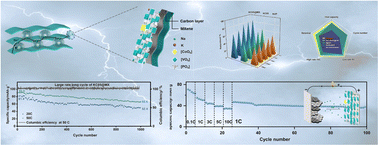Constructing a multidimensional porous structure of K/Co co-substituted Na3V2(PO4)3/C attached on the lamellar Ti3C2Tx MXene substrate for superior sodium storage property †
Abstract
Na3V2(PO4)3 (NVP) materials have emerged as prospective cathodes for sodium-ion batteries (SIBs). However, its weak intrinsic conductivity has limited deeper research. Herein, we adopt the strategy of simultaneous K/Co co-substitution and Ti3C2Tx MXene (MX) introduction to optimize NVP. The K/Co co-substitution brings about the synergetic effect of NVP framework stabilization. Doping Co2+ generates beneficial holes and accelerating electronic conductivity. The MX plates are stacked at random to form a porous construction, increasing the contact areas to provide more active sites for Na+ shuttling and buffering the volume change. Furthermore, the lamellar MX and the carbon layers form efficient conductive networks that increase electron migration. Notably, K0.1Na2.95V1.95Co0.05(PO4)3@MX (KC05@MX) exhibited an initial capacity of 116 mA h g−1 under 1 C with an extraordinary retention of 86.8% at the 400th cycle. It realized high performance under 20 C and 50 C, and the outputs were 93.5 and 82.4 mA h g−1 at the 1st cycle and 66.6 and 53.4 mA h g−1 at the 1000th cycle, respectively, with slight capacity loss at 0.028% and 0.035%. Furthermore, the Bi2Se3//KC05@MX asymmetric full cell expressed great electrochemical properties, indicating the superior practical application prospect of KC05@MX.



 Please wait while we load your content...
Please wait while we load your content...